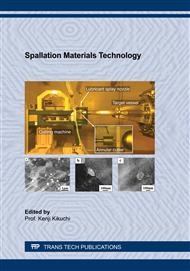[1]
K. TSUJIMOTO, H. OIGAWA, K. KIKUCHI, Y. KURATA, M. MIZUMOTO, T. SASA, S. SAITO, K. NISHIHARA, M. UMENO, H. TAKEI, FEASIBILITY OF LEAD-BISMUTH COOLED ACCELERATOR-DRIVEN SYSTEM FOR MINOR-ACTINIDE TRANSMUTATION,, NUCLEAR TECHNOLOGY, VOL, 161, MAR. 2008, pp.315-328.
DOI: 10.13182/nt08-a3929
Google Scholar
[2]
Hiroyuki Oigawa, Kazufumi Tsujimoto, Kenji Nishihara, Takanori Sugawara, Yuji Kurata, Hayanori Takei, Shigeru Saito, Toshinobu Sasa, Hironari Obayashi, Role of ADS in the back-end of the fuel cycle strategies and a ssociated design activities: The case of Japan,, Journal of Nuclear Materials, 415, pp.229-236, (2011).
DOI: 10.1016/j.jnucmat.2011.04.032
Google Scholar
[3]
Takanori Sugawara, Yuta Eguchi, Horonori Obayashi, Hiroko Iwamoto, Kazufumi Tsujimoto, Nuclear engineering and design 331, 2018, pp.11-23.
Google Scholar
[4]
P. N. Martynov, Y. I. Orlov, A. D. Efanov, V. M. Troiynov, A. E. Rusanov, O. V. Lavrova, Technology of lead-bismuth coolants for nuclear reactors,, Proc. of the ISTC-TITech Japan Workshop on Nuclear Reactor Technologies in Russia/CIS,pp.80-105, (2001).
Google Scholar
[5]
H. J. T. Ellingham, Reducibility of Oxides and Sulphides, J. Soc. Chem Ind. Trans., 63, pp.125-133, (1944).
Google Scholar
[6]
Kenji KIKUCHI, Shigeru SAITO, Yuji KURATA, Masatoshi FUTAKAWA, Toshinobu SASA, Hiroyuki OIGAWA, Eiichi WAKAI, Makoto UMENO, Hiroshi MIZUBAYASHI, Kuniaki MIURA, Lead-Bismuth Eutectic Compatibility with Materials in the Concept of Spallation Target for ADS, JSME International Journal, Series B, Vol. 47, No. 2, 2004, pp.332-339.
DOI: 10.1299/jsmeb.47.332
Google Scholar
[7]
K. Kikuchi, S. Saito, D. Hamaguchi, M. Tezuka, Ni-rich precipitates in a lead bismuth eutectic loop, Journal of Nuclear Materials 398, 2010, pp.104-108.
DOI: 10.1016/j.jnucmat.2009.10.018
Google Scholar
[8]
G. S. Bauer, M. Salvatores, G. Heusener, MEGAPIE, a 1MW Pilot Experiment for a Liquid Mertal Spallation Target, JAERI-Conf. 2001-002, 15th ICANS XV, November 6-9, 2000, Tsukuba, pp.1146-1162.
DOI: 10.1016/s0022-3115(01)00561-x
Google Scholar
[9]
Yamaki, E., Kikuchi, K., 2010. A stability of oxide scales formed in LBE on HCM12A to external loading. Journal of Nuclear Materials 398, p.153–159.
DOI: 10.1016/j.jnucmat.2009.10.026
Google Scholar
[10]
Kikuchi, K., Kamata, K., Ono, M., Kitano, T., Hayashi, K., Oigawa, H., 2008. Corrosion rate of parent and weld materials of F82H and JPCA steels under LBE flow with active oxygen control at 450 and 500oC. Journal of Nuclear Materials 377, p.232–242.
DOI: 10.1016/j.jnucmat.2008.02.047
Google Scholar
[11]
Shigeru Saito, Kenji Kikuchi, Dai Hamaguchi, Kouji Usami, Shinya Endo, Katsuto Ono, Hiroki Matsui, Masayoshi Kawai, Yong Dai, Journal of Nuclear Materials 431 (2012) p.44–51.
DOI: 10.1016/j.jnucmat.2011.11.028
Google Scholar
[12]
R.L. Klueh and M.P. Tanaka, Steels for Fusion Reactor Applications, Journal of Metals, Vol.37, No.10, 1985, P.16-23.
Google Scholar
[13]
Abu Khalid Rivai, Shigeru Saito, Masao Tezuka, Chiaki Kato, Kenji Kikuchi, Journal of Nuclear Materials 431 (2012) 97–104.
Google Scholar
[14]
D. Caplan, G.I. Sproule, R.J. Hussey, Corros. Sci. 10 (1970) p.9.
Google Scholar
[15]
J.C. Langevoort, T. Fransen, P.J. Gellings, On the Influence of Cold Eork on the Oxidation Behavior of Some Austenitic Stainless Steels: High Temperature Oxidation, Oxidation of Metals, Vol.21, Nos.5/5 1984, p.271.
DOI: 10.1007/bf00656836
Google Scholar
[16]
Ken-ichi HAYASHI, Mikinori ONO, Kenji KIKUCHI, Noriya TOKUNAGA, Teruaki KITANO and Hiroyuki OIGAWA, Transactions of the Atomic Energy Society of Japan, Vol.7, No.1, 2008, pp.44-57.
DOI: 10.3327/taesj.j07.002
Google Scholar
[17]
Gene Dannen, The Einstein-Szilard Refrigerators, Scientific American, January 1997, p.95.
DOI: 10.1038/scientificamerican0197-90
Google Scholar
[18]
Information on https://mdx.plm.automation.siemens.com/.
Google Scholar
[19]
Information on https://www.ssil.co.jp/product/EMSolution/ja/about/.
Google Scholar
[20]
G. Müller, G. Schumacher, F. Zimmermann, Investigation on oxygen controlled liquid lead corrosion of surface treated steels, Journal of Nuclear Materials 278, 2000, pp.85-95.
DOI: 10.1016/s0022-3115(99)00211-1
Google Scholar


